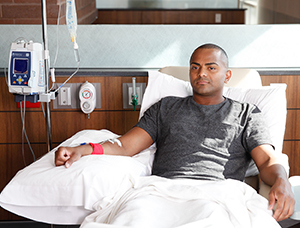Understanding Chemotherapy
Chemotherapy (chemo) is a treatment for cancer. Chemo can be a single medicine. Or it can be a combination of medicines. Chemo can be used alone. Or it can be used along with surgery, radiation therapy, and other treatments, such as hormone therapy, targeted therapy, and immunotherapy. It can often shrink a tumor or prevent its spread. Chemo is a systemic medicine. This means it travels through the blood to all parts of the body.
 |
| Chemotherapy is often given in an outpatient setting. This means you don’t stay overnight in the hospital. |
How chemotherapy works
Chemo kills cells that grow quickly. It works by keeping cancer cells from dividing, growing, and making more cancer cells. Many kinds of cancer cells grow fast. But many healthy cells grow fast, too. These include cells of the mouth, stomach lining, bone marrow, skin, and hair. After chemo, these healthy cells are able to grow back. But the cancer cells die. That's why some chemo side effects get better with time. Side effects can include:
-
Hair loss
-
Upset stomach (nausea)
-
Low blood cell counts
There are many methods to give chemo. These include:
-
By mouth, as a pill or liquid (oral)
-
By IV (intravenously) into a vein
-
By a shot (injection)
-
Into the belly (intraperitoneal)
-
Into the bladder (intravesical)
Usually, chemo is given in cycles of treatment. A cycle is the time from one cancer treatment to the next. For instance, a 3-week cycle may be treatment given 2 weeks in a row, and then 1 week off. A 3-week cycle may also be treatment given once every 3 weeks. Time is needed between treatments during the cycle. This lets normal cells recover before the next treatment.
The goals of chemotherapy
Chemo can kill cancer cells. As a result, it may do the following:
-
Shrink cancer before surgery. This is called neoadjuvant treatment.
-
Kill cancer cells that may remain after surgery. This is called adjuvant treatment.
-
Reduce symptoms, such as pain. This is called palliative care.
-
Control cancer for a period of time. This is also a kind of palliative care.
-
Cause remission. This means there is no sign of the cancer on medical tests.
-
Cure the cancer. This means the primary treatment is to kill all the cancer cells and keep them from coming back. This means there is no sign of the cancer years after treatment.
Side effects of chemotherapy
Side effects depend on the cancer, location, type of medicines, and dose of chemo you are given. Because healthy cells are also damaged with chemo, you may have side effects, such as:
-
Nausea and vomiting
-
Appetite changes
-
Hair loss
-
Low red blood cell count (anemia)
-
Low white blood cell count
-
Low platelet count
-
Infections
-
Bleeding
-
Mouth and throat sores
-
Weight changes
-
Skin changes, such as dry skin, itching, and acne
-
Lack of interest in sex
-
Severe tiredness (fatigue)
-
Trouble remembering and focusing
-
Stress and depression
-
Constipation or diarrhea
-
Numbness in hands and feet
Long-term risks
There are some long-term risks with chemo. But the benefits usually outweigh the risks. Risks depend on the type and dose of chemo used. Some possible long-term risks include:
-
Being unable to have children (infertility)
-
Damage to some organs, such as the heart, kidneys, liver, or lungs
-
Lasting nerve damage
-
Another cancer growing at a later time